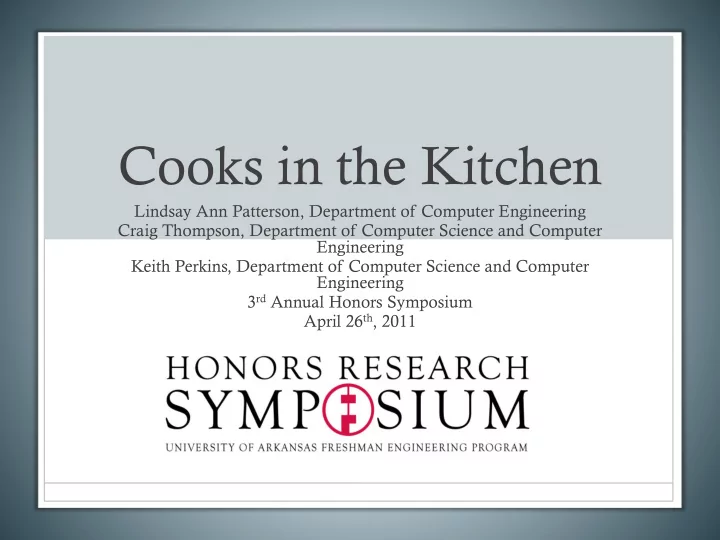

Cooks in the Kitchen Lindsay Ann Patterson, Department of Computer Engineering Craig Thompson, Department of Computer Science and Computer Engineering Keith Perkins, Department of Computer Science and Computer Engineering 3 rd Annual Honors Symposium April 26 th , 2011
Everything is Alive • Through the “Everything is Alive” project, directed by Dr. Craig Thompson, researchers at the University of Arkansas are using Second Life to model “workflow,” or the routine used by people for everyday activities. • This has been modeled through operations in a virtual hospital and a pharmacy. For our project we decided to make a virtual restaurant. Patterson 2
Second Life • The goal of this project was to use the scripting programs developed by the Everything is Alive project to simulate the workflow in a restaurant in the program Second Life . • Second Life is a 3D virtual world created by Linden Lab. Residents, the users of the software, build and modify the world as they wish. The players control a humanoid avatar in the world of Second Life , and it is with this that they make all their interactions. Patterson 3
Why Model Workflow? • To better understand routines and human actions • To increase workplace efficiency and safety • To study the way humans interact with the objects and world around them , Patterson 4
Steps for Modeling Workflow • Build the environment for the simulation (in this case, the restaurant) in Second Life • Build “props” (food, tables, ovens) for avatars to interact with • Build animations to interact with props • Script out the workflow by hand • Script the workflow in a program and run it in Second Life Patterson 5
Current Problems with Workflow Modeling • There are still many problems with workflow simulation via Second Life • Second Life is not built for this kind of modeling, so programming is having to be done from scratch for many types of animations and sequencing • Another problem lies in the bots’ inability to interact with human-controlled avatars, as well as in their inability to adapt to changes in their environment or to reason Patterson 6
Our Main Goals • A basic knowledge of sequencing animation and workflow modeling • New animations to add to the current repertoire of animations used in workflow modeling • Ideally, improved efficiency for a restaurant kitchen layout Patterson 7
First: Building the restaurant Objects and other aspects of the environment are built entirely out of geometric shapes, linked together to make bigger, detailed objects. Patterson 8
Our Restaurant Patterson 9
Kitchen in the Early Stages Patterson 10
After building our restaurant, the next step was to create animations using a program called QAvimator, which was specially created for making Second Life. This is a user-friendly program that allows for frame-by-frame animation. Patterson 11
QAvimator Patterson 12
Side View Top View Patterson 13
Animations in Second Life Patterson 14
With that complete, we scripted out our workflow and entered it into a coding program, then ran the completed workflow. Patterson 15
Workflow Script Patterson 16
Some Challenges • To put it bluntly… • Everything had to be moved as precisely as possible • Avatarbots must be guided • Some issues with believable animation Patterson 17
Our Restaurant Workflow Patterson 18
Possibilities for Future Research • The restaurant project was very minimalist due to time and could be greatly expanded on • There is ongoing research on hospital and pharmacy workflow • Look into warehouses and factories as well due to large staff and inventory Patterson 19
Resources • All photos taken within Second Life , copywright Lindon Research, Inc. • Scripting programs developed by Keith Perkins and the Everything is Alive team. Patterson 20
Any Questions? Patterson 21
Recommend
More recommend